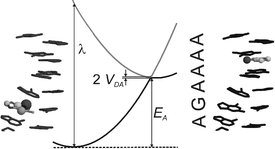Static and dynamic aspects of DNA charge transfer: a theoretical perspective
Abstract
In this work, we approach the impact of dynamic and static disorder on DNA charge transfer from a theoretical and numerical perspective. Disordered or defect geometries are either realized via molecular dynamics simulations using a classical force field or by experimentally determined DNA bulge structures. We apply a chemically specific, atomically resolved extended Su–Schrieffer–Heeger model to compute the energy parameters relevant to DNA charge transfer. For both models studied here, the effective donor–acceptor couplings—and hence the charge transfer rates—significantly depend upon the geometry. Dynamic disorder leads to a correlation time in this quantity of the order of 30 fs, and the transfer rates universally exhibit a broad, yet well-defined, exponential distribution. For DNA bulges, the angle characterizing the defect controls the charge transfer efficiency. The results are discussed and extensively compared to experimental findings and other calculations.


 Please wait while we load your content...
Please wait while we load your content...